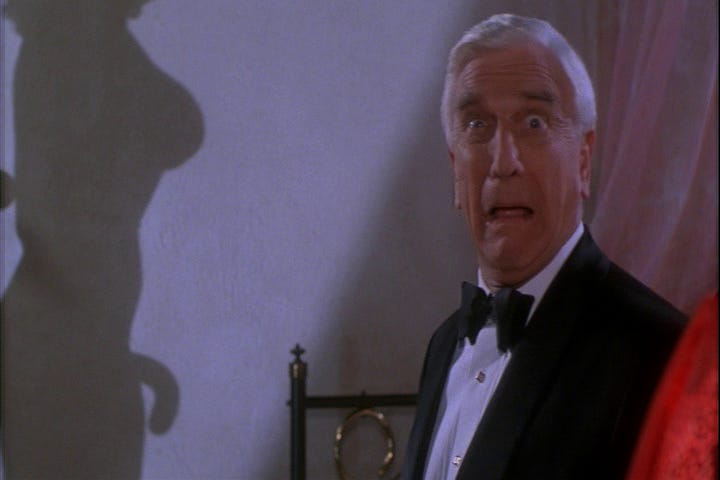The Transsexual Shadow: Spectacle and Absence in 'Naked Gun 33 1/3'
[Here's something I wrote in 2015; I've changed a lot as a writer and thinker, but I like this piece still. All images taken from the film in question.]
There’s a trans character in the 1994 American comedy Naked Gun 33 1/3: The Final Insult, and the film reveals her trans status in a scene clearly meant as a parody of 1992′s The Crying Game, down to the set dressing. As trans woman Tanya (Anna Nicole Smith) undresses in front of Frank (Leslie Nielsen), we switch from Frank’s eyeline to one that shows him in profile and casts her out of frame. Only her shadow remains.
It is, effectively, her shadow with which he interacts next.
Her penis outs her to Frank and to the audience. Frank bolts from the scene, and Tanya, who did at least have some appearances and lines in the film up to this point, is now gone. She will not appear in the film again. Unlike the other two villains, who are killed, she is defeated merely by the existence of her genitalia.
As the reveal happens, she is increasingly de-personalized. First, she becomes a shadow, and she ceases to speak or move in any major way. As Frank reacts, she stands still, un-reactive, reduced to a prop in a sight gag. The moment she is revealed as trans, she becomes not real, un-depictable. The camerawork stands in stark contrast to the deliberately excessive male-gazing that previously marked the character. An earlier appearance saw a camera, Frank’s POV, draw slowly up Tanya’s legs and onto her body (the camera that moves up her legs passes two sets of knees, another interruption of bodily and visual norms that presages her reveal as trans). When she is thought to be cis, she is a spectacle, marked by visual excess that revels lustfully in the sight of her body.
But once she is trans, she can only be depicted by proxy. She’s still a spectacle, still a form of visual excess, but in a different way. Her body halts the narrative, interrupting Frank’s erotic look, disrupting visual norms. For that reason, it seems, the narrative removes us from Frank’s view, allowing the audience (the hypothetical audience to whom Frank turns, horrified, looking for an audience in agreement with his reaction) relief from the sight that traumatizes Frank. The audience, in other words, doesn’t have to look at her, only a cartoonish facsimile, and that telegraphs as much as Frank’s face that her body is too horrifying and shocking to look at directly.
What the film really illustrates is a paradox of trans representation: trans women are so often positioned as visual spectacles, interruptions to society’s structures of seeing, yet simultaneously are deprived of meaningful presence. So often, trans women in cinema, indeed in any form of outsider representation, are merely shadows projected on a wall.







LMAO ! That scene was extremely funny and that's all. There's no reason to force any philosophy into this message. Trump is cleaning up this mess.
Spicy take on the scene. "defeated merely by the existence of her genitalia". Considering how she is the only villain in the entire series who gets away scot free and is actually never defeated, that seems a hundred percent reverse of what actually happens.